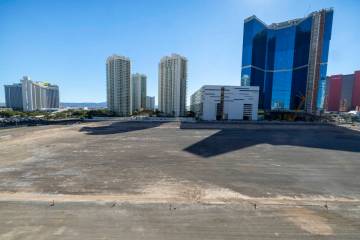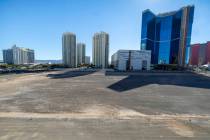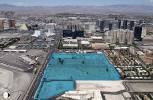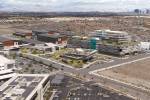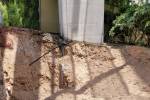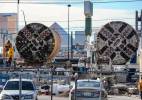Boosters for new UNLV campus stadium now have to figure how to pay for it
Boosters behind building a UNLV campus stadium have reached that delicate twist in the road.
Now it’s time to figure out ways to pay for the 50,000-seat stadium, which would cost more than $700 million if it’s a retractable roof venue.
And that’s not counting another $100 million to $200 million for infrastructure like parking garages and road improvements.
That could add up to more than $900 million, nearing the cost of a previous “Mega-Event Center” stadium proposal that drew the opposition of MGM Resorts International in early 2013. Soon after, University of Nevada, Las Vegas officials parted ways with their former development partner, Majestic Realty, pulling the plug on the $950 million mega-events stadium project 15 months ago.
Now, UNLV’s 11-member panel charged with determining the venue’s cost, scope and funding will receive its most sobering news to date on the project on Thursday, when its consultant, Plano, Texas-based Conventions, Sports &Leisure International, offers a variety of stadium funding options.
CSL principal Bill Rhoda said Nevada, compared to other states, has fewer stadium tax options.
“We are somewhat limited on what is available as compared to other states,” Rhoda said. “Our analysis will include a review of all possible tax and revenue sources.”
The funding model for a proposed UNLV stadium will be very different from other campus stadiums around the country.
For example, new stadiums or stadium improvements at Texas A&M, Baylor and Texas Christian University were funded, in part, by upfront donations tied to seat locations, Rhoda said.
“We don’t believe this is a viable alternative for a new stadium in Las Vegas,” he said.
Rhoda pointed out that the UNLV stadium is very different from all collegiate venues, because it would leverage the nearly 40 million annual visitors in a market known for entertainment.
“If this new stadium gets built, it is not primarily to serve the needs of the UNLV football team, although that team would play in this new stadium and benefit from it,” Rhoda said.
“The new stadium concept is based on the proven track record of the (Thomas &Mack Center), where even today the vast majority of the revenue comes from non-UNLV activities.”
LOCATION, LOCATION, LOCATION
Not only do stadium board members need to figure out how to pay for the stadium, they also are faced with finding a suitable location after UNLV officials this month dropped the proposed site along Swenson Street on the campus’ west side.
Now, university officials are looking at a site next to the Thomas &Mack Center or a 42-acre off-campus site a short walk away at Tropicana Avenue and Koval Lane.
When it comes to pursuing stadium funding, Don Snyder, UNLV acting president and stadium board chairman, has been down this road before.
When UNLV and Majestic worked on the previous stadium proposal, Snyder went looking for funding sources, focusing mostly on hitting up visitors and tourists and not local residents.
The previous funding ideas included tourist taxes, such as charges on hotel rooms, rental cars and taxis.
Other considerations were sin taxes on liquor and cigarettes; live entertainment fees on nightclubs and strip clubs; and even a novel idea of charging convention show exhibitors a square-footage charge and an admission fee on convention show badges.
Politically, all those funding ideas were crushed behind the scenes.
Publicly, a potential public money-maker for an on-campus venue was a tax increment financing district on the UNLV campus that would generate income from taxes on food, beverages and items bought from stores in the district.
But the proposed tax district was removed from the state legislation approved last year to create the 11-member UNLV stadium board. And besides, that campus tax district would have generated only a small fraction of the money needed to build a stadium.
A similar concept was suggested for a Strip arena in 2007. Backers of an unsuccessful Harrah’s Entertainment arena had floated the idea of creating a sales tax zone around the arena to create revenue to help build the venue, recalled Jeremy Aguero.
A principal of Applied Analysis, a public policy and economic analysis company in Las Vegas, Aguero also worked on the previous UNLV-Majestic stadium proposal.
Asked which current tax would be most politically palatable to raise money for a new UNLV stadium, Aguero sidestepped the inquiry by laughing and describing that as a “loaded question.”
THE DEBATE OVER PUBLIC DOLLARS
It’s unclear how much the casino-hotel companies or tourism agency, the Las Vegas Convention and Visitors Authority, would be willing to kick in to help build the stadium.
UNLV cut ties to Majestic Realty last year even though Majestic had committed $360 million to the project. But UNLV officials changed course, cutting loose Majestic in favor of creating a partnership with the Las Vegas resort industry, an industry that has not indicated how much it is willing to contribute to building the stadium.
Opponents of public stadium funding argue that taxpayers get fleeced when public dollars are used to build these revenue-making sports and entertainment venues.
Clark County Commission Chairman Steve Sisolak said he opposes earmarking any property or sales taxes for a UNLV stadium.
“I would think they would have dealt with this issue before now,” Sisolak said.
He noted that because visitors coming to Las Vegas for stadium events would be staying in local hotels, “you can make an argument” that some public dollars collected from hotel room charges could potentially be used for the stadium.
Other than that, he opposed public money for a UNLV stadium.
“Now is not the time,” Sisolak said.
In the past, local projects have tapped tourists for money to help build their facilities. Bear witness to The Smith Center for the Performing Arts, which Snyder helped build and which was partially funded by rental car money.
But when UNLV was partnering with Majestic and Snyder approached the LVCVA for stadium money, he received a cool response.
The convention authority, after all, has its own major facility project: a $2.5 billion convention center expansion and improvement proposal that is seen as the region’s top priority.
FUNDING MECHANISMS VARY
The Review-Journal reviewed stadium funding methods across the country and found three major ways of paying for these sports venues: sales taxes; tourist charges on hotel rooms and car rentals; and a hodgepodge of other methods, ranging from lottery revenues in Maryland to food and beverage charges in Seattle’s King County.
In Denver, a sales tax increase was used to pay for a football stadium and a baseball park.
Same for Cincinnati’s Hamilton County, where sales tax revenue helped pay for new palatial venues for the NFL Bengals and Major League Baseball’s Reds.
Tampa’s Hillsborough County also is raising hundreds of millions of dollars with a sales tax to pay for a new NFL stadium.
Sometimes, it’s hotel taxes. Room fees helped build NFL stadiums in St. Louis, Cleveland, Detroit, Houston, Indianapolis and Jacksonville, Fla.
In Miami-Dade County, the NFL’s Dolphins proposed to stop paying nearly $4 million in annual property taxes at Sun Life Stadium in return for a privately funded $350 million renovation.
The UNLV stadium board, made up of regents members, casino-hotel representatives and local officials, still needs to figure out whether it will be an open-air or enclosed stadium; the exact number of seats; the location; and the costs of both construction and related infrastructure.
Cost projections are $714 million for a retractable-roof stadium; $664 million for a dome; $514 million for an open-air stadium with a 125-foot shading system; and $490 million for an open-air.
The stadium panel is required to submit a stadium report to the state Legislature by Oct. 1.
Contact Alan Snel at asnel@reviewjournal.com or 702-387-5273. Find him on Twitter: @BicycleManSnel







